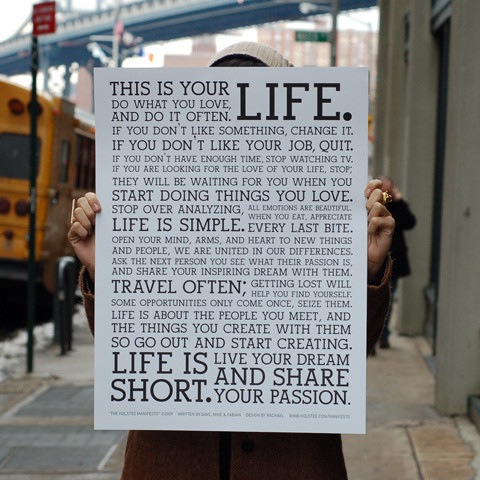There are many fledgling businesses that have laudable intent and shaky commercial foundations.
This is a problem because, in an ideal world, the businesses that stand for values we share should also be able to sustain themselves as businesses. That’s the key premise underneath social entrepreneurship and conscious capitalism.
Purpose-driven organizations need compelling values, but they also need coherent business models.

People want to buy products that support values they believe in. To meet this consumer need, some businesses now make their values visible in their products and services, and sell them to customers who share those very values.
But what happens when the values are more popular than the products, as with Holstee and their Holstee Manifesto? What kind of business can you create then?
This problem of organizations with compelling values that can’t seem to make a business out of them came to mind when a friend shared a Washington Post article about a company called Holstee. Holstee is experiencing a somewhat dramatic version of this problem.
Holstee has a company values statement that people are crazy about and a business model that is underwhelming.
Who is Holstee?
Holstee is a Brooklyn-based, mostly e-commerce business that sells clothing and accessories described as “products with a conscience.” These products include upcycled wallets, t-shirts, messenger bags, and similar lifestyle items.
By designing and curating with a conscience, Holstee offers a place for mindful shoppers to find meaningful products.
However, Holstee doesn’t seem to support itself by selling these lifestyle products. Instead, Holstee supports itself by selling its actual values — The Holstee Manifesto — in the form of a poster.
The Holstee Manifesto
The Holstee Manifesto is the Holstee founders’ life vision put into words. It’s been typeset and printed on high-quality paper stock, and is sold on the Holstee website.

The Holstee Manifesto is Holstee’s most popular product.
So far, the Manifesto has been viewed over 500 million times and translated into 12 languages. There are Flickr groups, Facebook conversations, and blog post after blog post focused on how inspiring the Holstee manifesto is. Holstee sold over 11,00 posters in 2011, at $25 a pop, and posters accounted for half of Holstee’s revenue in Nov. of 2011.
Holstee “isn’t a Manifesto Company”
In an interview in Inc. magazine, the founders explain that
“We’re not a manifesto company, whatever that would be. The success of the posters helped us bootstrap, but at the end of the day, we’re about products with a unique story that are designed with a conscience.”
I’d take those words at face value, if it wasn’t for Holstee’s second most popular product.²
Holstee’s “Lifecycle” video sets the Manifesto to evocative images and music. Released only three months ago (Nov 2011), the Lifecycle video has been viewed almost 900,000 times to date, and has inspired its own Tumblr.
Clearly, Holstee is putting time, money, creative energy, and not a little bit of love into sharing their Manifesto. Why, then, aren’t they a manifesto company?
Is Holstee a Manifesto Company?
If half of your revenue, the majority of your units sold, and 99% of your public’s awareness can be attributed to the manifesto you sell, aren’t you a manifesto company?
And, given the hundreds of companies that sell ethically-sourced, free trade, biodegradable t-shirts, isn’t there something neat about being the only one also selling a Manifesto?
In the words of Holstee’s founders,
If that’s true, what does that tell the founders about what really matters to them, as a business?
Is there a business behind the values statement?
The 50 million and 900,000 views that the Manifesto is generating are telling Holstee that there is demand for the values in their Manifesto to be articulated, shared, and made visible.
But while the millions of views are good public relations, they aren’t helping Holstee they way(s) they could be, since these page views aren’t making Holstee any money.
I don’t know how much non-manifesto merchandise Holstee is selling, but using sales from the Manifesto to bootstrap their non-manifesto product business suggests that the products are not selling enough to sustain the business on their own.¹
- Why does Holstee see their Manifesto as a short-term way to provide start-up capital (i. e., as bootstrapping) but not as a source of ongoing, growing revenue?
- Why hasn’t Holstee “productized” and monetized the Manifesto further?
- Why can’t people buy the Manifesto on mugs and mousepads?
Holstee is leaving a lot of money on the table.
When the posters of your values statement outsell your intended product line, you’ve got a business problem and a business opportunity.
The market is telling Holstee something.
The market is telling Holstee that their values are more desired than their current products. And, the market is telling Holstee that it’s missing an opportunity to meet consumers’ needs and to build themselves a sustainable business by promoting the values in their manifesto.
Right now, Holstee doesn’t seem to have a business model that fully supports their values. They need to rethink their busiess plan, and they need to ask themselves what kind of business they are, and what kind of business they want to be.
A Lifestyle Products Business?
If Holstee wants to be a Brooklyn-based purveyor of clothing and accessories “with a conscience”, they might focus on developing a product mix that conveys their values more prominently.
Maybe Holstee’s non-manifesto products are too generic, too subtle, too hard to interpret, or just not “symbolic” enough. Maybe there aren’t enough options to ‘speak’ to the variety of customers looking to purchase from Holstee. Maybe Holstee as an organization is currently more skilled at putting ideas into words than it is at curating symbolically compelling functional objects.
A Life Inspiration Business?
If Holstee wants to be a Brooklyn-based organization devoted to inspiring individuals’ hopes and dreams for a meaningful life, they might look for different ways to convey the actual words of their Manifesto.

Can’t Holstee capitalize on people’s desire for inspiration? Look at all the “Keep Calm and ….” merchandise — all purchased by people who want a reminder of what’s important to them.
Maybe what consumers want is the most streamlined exchange possible, where they literally buy the meaning itself, so that the item on which the words are placed is largely irrelevant.
There’s nothing wrong with mousepads and mugs with inspiring words on them. Words printed on various everyday items aren’t any less noble or less impressive than t-shirts. They can all be made “with a conscience”.
What should Holstee do to match its business model and its values?
Should Holstee develop the organization’s capacity to translate their values into products so that the products are more meaningful?
Or, is it time for Holstee to pivot, and change their business model so that they are selling the values directly through words and images?
Either way, don’t you think that Holstee should do more with their Manifesto?
¹ I’m interpreting and opining based on publicly available information. There may be important details I don’t know about that would reshape the conversation. If so, I’d love to learn about them. Email me at cvharquail at authentic organizations dot com.
² Measured by page views.
Also, I hear from mutual friends that the Holstee founders are lovely people, which you’d expect given the ideas in the manifesto.
See also:
Why Your Company Should Have A Social Mission, by Olivia Khalili at CauseCapitalism.com
Communities of Commerce: Where the Marketplace is also the Meaning Place
Their Need or Your Ability: Why does your organization exist?
Make Distinctiveness Matter by Linking It To Organizational Purpose
Images: © Holstee and AllPosters
Hat tip: I was introduced to Holstee by @BrainPicker. I’ve been to their site to see what I could buy to support them, and I bought a poster that’s now on our refrigerator.
 I am an organizational consultant, change advocate, and organizational identity/reputation scholar with a PhD in leadership & organizations. I research, write about, and consult with organizations on the relationships between organizational identity, actions, and purpose. I teach Technology Management, part-time, at Stevens Institute of Technology.
My current research focuses on how social technologies in the workplace can drive organizational change, generate meaning, and catalyze purpose. See the
I am an organizational consultant, change advocate, and organizational identity/reputation scholar with a PhD in leadership & organizations. I research, write about, and consult with organizations on the relationships between organizational identity, actions, and purpose. I teach Technology Management, part-time, at Stevens Institute of Technology.
My current research focuses on how social technologies in the workplace can drive organizational change, generate meaning, and catalyze purpose. See the 
Comments on this entry are closed.